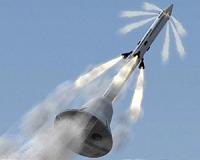 |
Huntsville AL (SPX) Jun 18, 2010 "Having more than one string on a fiddle" is an old phase used to describe someone or something with multiple talents or uses. This expression could be used to describe NASA's avionics string testing - a developmental testing process that allows engineers to find and fix any bugs in a system by inputting commands and scrutinizing the electronics system's responses. NASA and ATK Aerospace Systems of Magna, Utah, prime contractor for the Ares I first stage avionics system, currently are conducting a series of string tests at ATK's test facility in Clearfield, Utah. So exactly what is an avionics system and how is NASA using string testing to help design the next generation of solid-rocket-motor-based launch systems? The avionics system is the "brains" for a launch vehicle, consisting of the electronics system, equipment and associated sensors responsible for controlling key guidance, launch, navigation and recovery hardware. The first stage avionics works with the upper stage flight computers and guidance systems to control the vehicle during first stage ascent and executes recovery of the first stage after staging. During testing, control boxes of the first stage avionics system are wired together in a line - the so-called string - with multiple strings making up the entire avionics system. The strings are connected to a ground computer which simulates the upper stage flight computer by issuing commands to the appropriate control box, requiring a particular response. "System level or "string" testing is a widely recognized process that allows our team to locate and identify functional and performance-related problems within the hardware," said Kendall Junen, avionics and control team lead for Ares Projects at NASA's Marshall Space Flight Center in Huntsville, Ala. "It involves taking various system requirements and testing the hardware in controlled laboratory scenarios to determine how well the system performs." "This laboratory allows us to test like you fly. We can assemble the entire avionics system and put it through precise, flight-like scenarios," he said. "We can test the system's reaction to certain computer-generated anomalies and identify potential performance issues associated with specific hardware." Testing is a vital part of the development process for launch vehicles to ensure the safest possible systems. For the avionics system this means reducing the possibility of failure by using redundant systems and commands. "For reliability, the single-fault tolerant system has redundant, independent lines or strings, either of which can perform the critical function." Junen said "So you might say we require more than one string for our fiddle. For safety, the system requires multiple, independent commands executed for every critical function - ensuring that a rogue signal doesn't prematurely trigger an event, such as a premature firing of the first-stage separation motors." Launch vehicles must withstand very harsh environments during launch, so the new avionics system was designed to be tough. To develop this new system, engineers took lessons learned from years of NASA and commercial technology into account, from the internal circuitry to the design of the avionics control boxes themselves; they added modern electronics and advanced, ruggedized packaging. "Our goal was to design a safe and reliable electronics system with the capability of functioning with any solid rocket motor," Junen said. "Our number one mandate: Keep it simple." "In designing this system, we incorporated a series of newly designed control boxes and modern electronic components with specially designed packaging techniques that virtually eliminated internal wiring," Junen added. "By keeping the electronics simple we have developed a highly reliable system that meets the stringent requirements necessary for human-rating our next-generation rockets and thereby helping to ensure the safety of our crews." Avionics development testing started April 2010 and will conclude in April 2011, followed by formal certification testing to be conducted at the Marshall Center.
Share This Article With Planet Earth
Related Links Marshall Space Flight Center Space Tourism, Space Transport and Space Exploration News
 Orion Spacecraft Takes Shape
Orion Spacecraft Takes ShapeNew Orleans LO (SPX) Jun 18, 2010 The Orion crew exploration vehicle took shape as the two halves of the crew module were fused together at NASA's Michoud Assembly Facility in New Orleans, La. The Lockheed Martin Orion team welded the forward cone assembly to the aft barrel assembly using the next generation friction stir weld process. The 445-inch long weld is the longest such weld of its kind and will ensure optimal structural ... read more |
|
| The content herein, unless otherwise known to be public domain, are Copyright 1995-2010 - SpaceDaily. AFP and UPI Wire Stories are copyright Agence France-Presse and United Press International. ESA Portal Reports are copyright European Space Agency. All NASA sourced material is public domain. Additional copyrights may apply in whole or part to other bona fide parties. Advertising does not imply endorsement,agreement or approval of any opinions, statements or information provided by SpaceDaily on any Web page published or hosted by SpaceDaily. Privacy Statement |